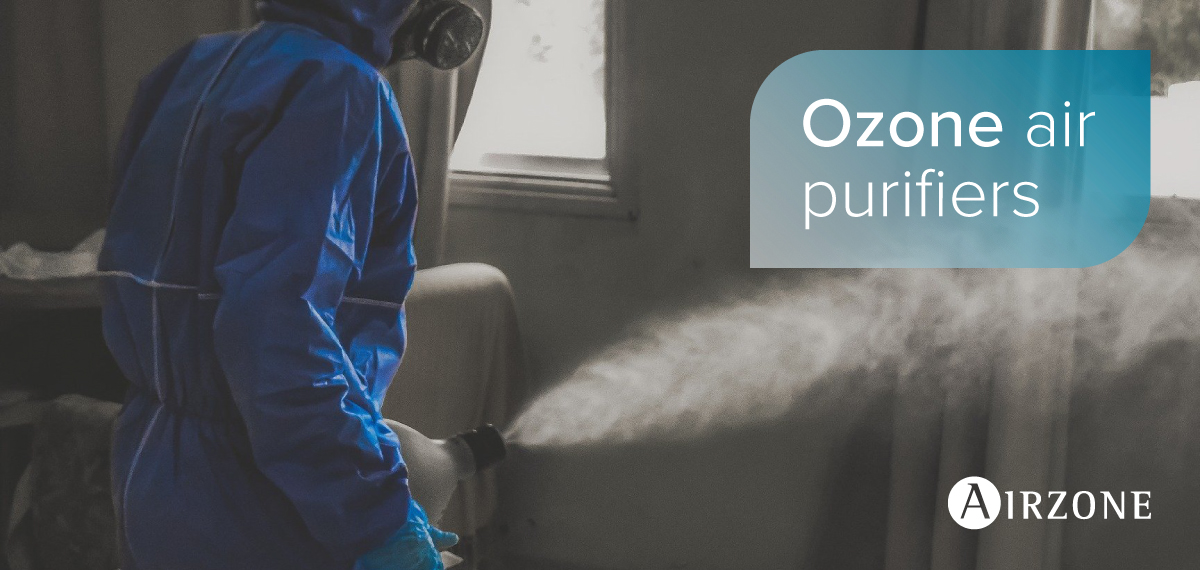


08 Jun 20

Ozone Air Purifiers
Essential to our planet's survival in the upper atmosphere, ozone is harmful if we breathe it, even in minute quantities. It irritates the respiratory system and eyes, causes coughing and shortness of breath, and reduces lung capacity. Are users of air purifiers fully aware of how they work, and the risks involved in inhaling Ozone?
A lot of promises are made when it comes to indoor air purification devices, and they are sold more and more, especially now with the current health crisis we are going through. There are many different techniques and the fact is that many of them emit large amounts of ozone to be efficient, as ozone is not effective cleaning the air unless used at extremely high, unsafe levels.
First of all, what is Ozone?
Ozone is a molecule composed of three oxygen atoms. It is a highly reactive, unstable, toxic gas. Ground level ozone is a major component of photochemical smog that plagues larger cities during the summertime. There is also a layer of ozone high up in the atmosphere, called stratospheric ozone, that protects us by reducing the amount of ultraviolet light entering the earth’s atmosphere. This beneficial ozone layer should not be confused with the harmful ozone that occurs at ground level.
How is it used?
Most devices claim that they kill viruses, bacteria, mold and even remove chemical contaminants and odors. However, studies have shown that, when ozone concentrations are below the health standards, it does not effectively remove biological contaminants. Ozone also does not remove particles (e.g. dust and pollen) from the air, including the particles responsible for most allergies. Research also shows that ozone generated by air purifiers does little to remove chemical pollutants. In fact, ozone has been found to react with existing chemicals in the air to create other toxic pollutants, most notably formaldehyde and ultrafine particles.
Some consumers purchase air purifiers to eradicate odors. Evidence shows that ozone concentrations below the health standards are not effective in removing many odor-causing chemicals. Ozone is also known to deaden one’s sense of smell. Not only does this disguise rather than eliminate odors, it can also have the dangerous effect of decreasing a person’s ability to detect high ozone levels.
What are the recommendations of health officers?
Health officers agree that if the use of a purifier is required it is essential to inform the subjects that the use of certain purification devices (ozonation, plasma, cold, ...) can lead to a degradation of indoor air quality following an incomplete degradation of pollutants leading to the formation of compounds potentially more harmful than the compounds being treated.
Some scientific data has been collected and analyzed concerning indoor air purification devices operating on the principles of catalysis or photocatalysis, plasma, ozonation or ionization and it does not demonstrate their effectiveness and safety on the health of users (particularly allergic and/or asthmatic subjects). It would be necessary to evaluate in real conditions the impact of the use of air purifiers on indoor air quality.It is frequently reminded that the most effective method to reduce exposure to indoor air pollutants, is through prevention. The first step is to ventilate and air out the indoor spaces, then, it is also possible to limit indoor air pollution by:
- Regularly maintaining the water heater.
- Mite control.
- Choosing non-polluting household products.
- Installing exhaust fans for ozone-producing equipment (photocopiers, etc.) and not placing such equipment in small confined spaces.
- Always maintaining office and industrial equipment and air handling systems properly.
- Using cleaning and maintenance products that do not contain large amounts of volatile organic compounds.
What are the adverse health effects associated with exposure to ozone?
The use of ozone-emitting devices can possibly aggravate the pathologies of asthmatics, but it can also cause damage to the respiratory system of people with no prior pathologies:
- Harming the cells in the lungs and respiratory airways
- Irritating and inflaming the lining of the respiratory system
- Causing coughing, chest tightness, and shortness of breath
- Contributing to the development of asthma
- Impairing breathing
Moreover, elevated exposures to ozone can cause permanent lung damage and repeated exposure can even increase the risk of early death among populations with poor health.
What information should be stressed?
Ozone is only effective at concentrations in the air that are dangerous to health and it also reacts with indoor air pollutants to form potentially harmful secondary pollutants. European regulations set an average daily exposure target of less than 60 ppb, well below the concentration emitted by an ozone generator. So, ozone air purifiers should be used in professional environments rather than in a domestic setting.
For now, no standards have been implemented to justify the effectiveness of air purification products, but regardless of the device used, it is important to maintain them with strict guidelines to prevent their leading to a deterioration in air quality.
Airzone does not manufacture or distribute air purification or disinfection products. This article has been written for explanatory purposes, following the research on the five most common air disinfection technologies in the market: ozone, UVC, photocatalytic oxidation, ionization and electrostatic filtration.
-
California Environmental Protection Agency, C. E. P. A., & Air Ressources Board, A. R. B. (2008, mars). Beware of Ozone-generating Indoor "Air Purifiers". ww3.arb.ca.gov
-
Dubuis, M. (2020, 10 avril). Ozone efficacy for the control of airborne viruses : Bacteriophage and norovirus models. www.journals.plos.org/plosone/. journals.plos.org
-
Indoor Air Quality (IAQ). (2020, 22 juin). US EPA. www.epa.gov
-
Leras, M. (2020, 14 avril). Coronavirus : de l'ozone pour désinfecter les véhicules. Le Parisien. www.leparisien.fr
-
Se dispara la demanda de empresas de desinfección por temor al coronavirus. (2020, 28 février). Antena 3 Noticias. www.antena3.com